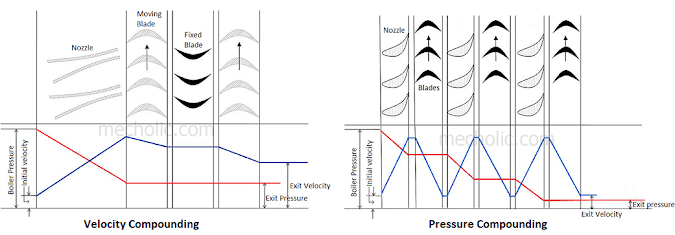Difference between Velocity Compounding Turbine and Pressure Compounding Turbine
🔗What is meant by compounding of turbine? What are the advantages of compounding?
🔗Velocity compounding - working with pressure velocity curve
🔗Pressure compounding working, advantages and disadvantages
🔗Velocity compounding - working with pressure velocity curve
🔗Pressure compounding working, advantages and disadvantages
Comparison between velocity compounding and pressure compounding
Velocity
Compounding turbine
|
Pressure
compounding turbine
|
Velocity/ Kinetic energy of steam is
converted to useful work in more than one stage.
|
Pressure energy of steam at turbine
input gradually extracted in multiple steps
|
Pressure of steam remains constant in every fixed blade and moving blades
except in the first nozzle.
|
Pressure of steam decrease in every nozzle (fixed blades)
|
Velocity of steam increase in every nozzle (fixed blade). Steam velocity decrease
in every moving blade
|
|
High velocity of steam inside the turbine.
|
Velocity of steam is low when compared to velocity compound turbine.
|
High frictional losses
|
Low frictional losses
|
Fewer number stages, and hence the
turbine length is short, require less space
|
Large number of stages and it is bulky, require more space.
|
It gives maximum output at the first
stage, work produced in the low-pressure stages is much less.
|
Same amount of work produced in each
stage.
|
Less efficient
|
More efficient
|
High steam consumption
|
Less steam consumption when compared
to velocity compounding.
|
Ratio of blade velocity to steam velocity is not constant (not optimum for
all blades)
|
Ratio of blade velocity to steam velocity is constant.
|
Steam pressure inside the turbine is
literally equal to the atmospheric pressure so there will be no problem of
steam leakage.
|
High pressure of steam inside the turbine. The chance of steam leakage
will be more when compared to velocity compounded turbine.
|
The casing of the turbine need not be airtight.
|
Turbine casing should be airtight.
|


